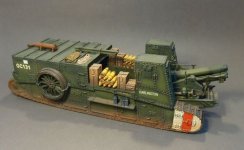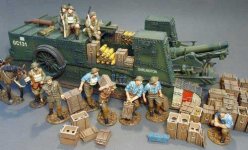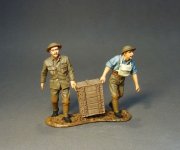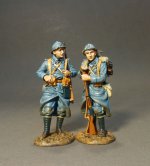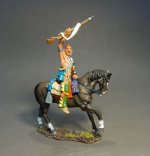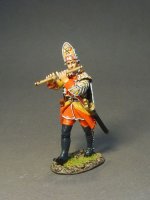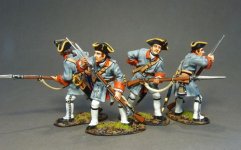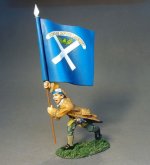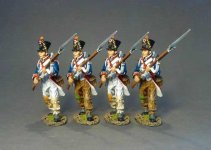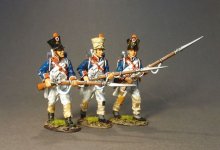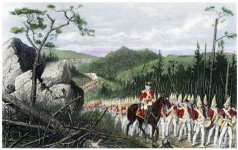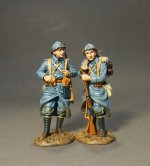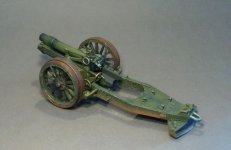Welcome to the April Edition of John Jenkins New releases. Written on what is supposed to be almost a Summers Day here in the Bay Area with temperatures in the 80’s. Not what we need at the moment, we want rain.
Thank you to all that visited the West Coaster and stopped by, as usual the feedback on John’s items was excellent especially his Aircraft and Woodland Indians, no surprise there.
After 8 years of posting John's News announcements on the forum, checking the weather and getting up at 5.00am to work on them, it is time for me to hand over the announcements to the newest member of John's Team, Suzie from “PR In The Works”, a new start up company. She will be working with John as an intern helping him with a Marketing campaign, Newsletters etc. So I hope you will enjoy her efforts starting next month.
Thank you to all for the great comments over the years, I hope you have enjoyed the newsletter as much as I do. I had tremendous fun putting them together.
We have terrific releases coming up, more than enough to make every collector very happy.
Hope you enjoy these as much as I do.
Mike
Sierra Toy Soldier Company
New Releases For April 2014!
I first met Michael and Myszka at the 2005 West Coaster Show, and since I released my first toy soldier sets in 2006, Sierra Toy Soldier have been outstanding in their support of my work.
Since the beginning Mike has been extremely generous in helping me out, by posting the news releases every month. I would like to take this opportunity to thank Mike for all those early mornings over the last eight years! That’s almost 100 cups of coffee….
As the administration work continues to grow and at times overwhelm me, not to mention taking me away from the creative work, it was on Michael’s suggestion that I try and get some professional help…. From a new start-up company that he highly recommended.
Next month’s releases will be handled by Suzie from “PR In The Works”.
THE GREAT WAR 1914-1918
The Gun Carrier Mark I was the first piece of self-propelled artillery ever to be produced.
During 1916 it became clear that in case of a breakthrough, the very purpose of the first tank, the Mark I, artillery would have great trouble following the advancing troops. Any successful offensive would therefore be in danger of stalling immediately. To solve this problem Major Gregg, an engineer working for the main tank producing company Metropolitan, Carriage, Wagon and Finance, proposed to build special mechanised artillery, using parts of the Mark I. The production of a prototype was approved on 5 June 1916; the actual design began in July. The first prototype was ready to participate in the Tank Trials Day at Oldbury on 3 March 1917. An order of fifty vehicles was given to Kitson & Co. in Leeds. Deliveries to the army started in June and ended in July.
The vehicle bore little resemblance to the Mark I. The tracks weren't tall but low, almost flat. At the back a rectangular superstructure covered the Daimler 105 hp engine together with the transmission of the Mark I, the latter now in a reversed position. Sharing it were the vehicle commander, a mechanic and two gearsmen. The original double tail wheel of the Mark I, intended to aid steering and attached to the rear of the vehicle, was retained. The front was an open area with either a 60-pounder (5-inch) field gun or a 6-inch howitzer.
GWB-10 BRITISH GUN CARRIER, MARK I, WITH 6-INCH HOWITZER, 1st Gun-Carrier Company, Tank Corps, 6th August 1918,
Retail us$298
Model Weight 2040g
For transporting the gun only the wheels had to be removed from the gun carriage - these were attached to the side of the carrier until needed again. In theory, the field gun could be fired from the vehicle; in reality only the howitzer could be so used. Alternatively the guns could be unloaded through a pivoting cradle buttisted by two winding drums driven by the engine. Above the front of the track frame at each side was an armoured cab for the driver on the left and the brakesman on the right. In the prototype these driving positions were directly in front of the superstructure; moving them forward improved visibility, but made communication very difficult - a problem as, in the Mark I, four men (including the gearsmen) had to cooperate to steer the tank.
In July 1917 two Gun Carrier Companies were formed of 24 vehicles each. Probably none of them ever fired a shot in anger
**PLEASE NOTE, THE GUN CANNOT BE REMOVED TO CREATE A COMPLETE SEPARATE ARTILLERY PIECE.
A SEPARATE 6”HOWITZER ARTILLERY SET WILL BE AVAILABLE IN A FEW MONTHS …ONCE I FINISH THE FIGURES TO ACCOMPANY THE SET.
GWB-23 BATTLE OF AMIENS, 6th August 1918, 58th 2/1st LONDON DIVISION, Tommies Unloading Supplies #3,
Retail us$78
The French army was manned by conscription, and every 20 year old male was liable for three years’ service. Most men would go into the infantry, and these were men primarily from an agricultural background, with those who had worked on railways, public works, shipyards and telecommunications going into the artillery.
Infantry Regiments were created on a local basis, similar to the British Pals battalions.
The peacetime army had a strength of 817,000 men, augmented on mobilization to 2,944,000.
During the war 7,800,000 men served with the “colours”, about 80% of the population of men eligible to fight.
Water was scarce in the front line, and the growing of facial hair led to the nickname “Poilu” (hairy one). The traditional nickname of the infantry was “Les Biffins” (the rag and bone men), initially to each other they were “Les bonhommes” (the lads), or as the war drew out, “Les pauvres cons du front” PCDF, (the poor bastards at the front).
GWF-20 BATTLE OF AMIENS, 6th August 1918, FRENCH INFANTRY 1917-1918, 123e Regiment of Infantry, 2 PCDF Standing,
Retail us$78
**PLEASE NOTE, ASK YOUR LOCAL DEALER TO INCLUDE PICTURE CARDS OF THE UPCOMING FRENCH INFANTRY IN YOUR NEXT ORDER**
THE RAID ON ST. FRANCIS
RSF-22A Mounted Woodland Indian, With Raised Musket (A),
Retail us$88
RSF-22B Mounted Woodland Indian, With Raised Musket (B),
Retail us$88
THE BATTLE OF THE PLAINS OF ABRAHAM 1759
During the reign of Queen Anne of Great Britain the English Army had become very disorganized and undisciplined. The Hanoverians (George I) who succeeded Queen Anne in 1714 reorganized the English Army, requiring the troops to march in step to proper military music. Thus fife & drum music was adopted by the British military (except for the Scottish regiments).
A company of about 100 men would have one or two fifers, and one or two drummers. When 8 or 10 companies were gathered together to form a regiment, their fifers and drummers were “banded” to form a regimental band.
The musicians provided music for the army on the march. As Napoleon would prove, music would be very effective in motivating an army to march long distances. The musicians were also used to broadcast various signals. Military camp life required a succession of daily signals: time to get up, breakfast call, sick call, buttembly, lunch, duty calls, dinner, evening retreat, lights-out (curfew).
The “Tattoo” comes from the Dutch die den tap toe which was a signal for the beer sellers to “turn off the taps” so that the soldiers could finish their beers and report back to camp. This signal consisted of the fifes and drums marching up and down the streets of the garrison town or camp, playing as they marched - at the end, they would stop marching, and conclude with a hymn.
While the army was encamped (or billeted in a city) the “officer of the day” (supervising at that moment) would always have a drummer with him to give impromptu and emergency signals: to sound “alarm” at an imminent attack or to call for a conference of the officers.
Contrary to common opinion, signals generally were NOT given during battles, excepting “cease fire” and related signals. The battlefield was too noisy and confusing, and, as the French discovered when they experimented with the idea in the 1750’s, the enemy can hear your signals.
QB-41 British, 35th Regiment of Foot, Fifer,
Retail us$40
The Regiment de Bearne saw much action under Montcalm, and was present at all major engagements of the war.
QF-40 REGIMENT de BEARN, Line Infantry Loading,
Retail us$79
QF-40N REGIMENT de BEARN, Line Infantry Loading, SET#2
Retail us$139
To Be Continued...............................................
Thank you to all that visited the West Coaster and stopped by, as usual the feedback on John’s items was excellent especially his Aircraft and Woodland Indians, no surprise there.
After 8 years of posting John's News announcements on the forum, checking the weather and getting up at 5.00am to work on them, it is time for me to hand over the announcements to the newest member of John's Team, Suzie from “PR In The Works”, a new start up company. She will be working with John as an intern helping him with a Marketing campaign, Newsletters etc. So I hope you will enjoy her efforts starting next month.
Thank you to all for the great comments over the years, I hope you have enjoyed the newsletter as much as I do. I had tremendous fun putting them together.
We have terrific releases coming up, more than enough to make every collector very happy.
Hope you enjoy these as much as I do.
Mike
Sierra Toy Soldier Company
New Releases For April 2014!
I first met Michael and Myszka at the 2005 West Coaster Show, and since I released my first toy soldier sets in 2006, Sierra Toy Soldier have been outstanding in their support of my work.
Since the beginning Mike has been extremely generous in helping me out, by posting the news releases every month. I would like to take this opportunity to thank Mike for all those early mornings over the last eight years! That’s almost 100 cups of coffee….
As the administration work continues to grow and at times overwhelm me, not to mention taking me away from the creative work, it was on Michael’s suggestion that I try and get some professional help…. From a new start-up company that he highly recommended.
Next month’s releases will be handled by Suzie from “PR In The Works”.
THE GREAT WAR 1914-1918
The Gun Carrier Mark I was the first piece of self-propelled artillery ever to be produced.
During 1916 it became clear that in case of a breakthrough, the very purpose of the first tank, the Mark I, artillery would have great trouble following the advancing troops. Any successful offensive would therefore be in danger of stalling immediately. To solve this problem Major Gregg, an engineer working for the main tank producing company Metropolitan, Carriage, Wagon and Finance, proposed to build special mechanised artillery, using parts of the Mark I. The production of a prototype was approved on 5 June 1916; the actual design began in July. The first prototype was ready to participate in the Tank Trials Day at Oldbury on 3 March 1917. An order of fifty vehicles was given to Kitson & Co. in Leeds. Deliveries to the army started in June and ended in July.
The vehicle bore little resemblance to the Mark I. The tracks weren't tall but low, almost flat. At the back a rectangular superstructure covered the Daimler 105 hp engine together with the transmission of the Mark I, the latter now in a reversed position. Sharing it were the vehicle commander, a mechanic and two gearsmen. The original double tail wheel of the Mark I, intended to aid steering and attached to the rear of the vehicle, was retained. The front was an open area with either a 60-pounder (5-inch) field gun or a 6-inch howitzer.
GWB-10 BRITISH GUN CARRIER, MARK I, WITH 6-INCH HOWITZER, 1st Gun-Carrier Company, Tank Corps, 6th August 1918,
Retail us$298
Model Weight 2040g
For transporting the gun only the wheels had to be removed from the gun carriage - these were attached to the side of the carrier until needed again. In theory, the field gun could be fired from the vehicle; in reality only the howitzer could be so used. Alternatively the guns could be unloaded through a pivoting cradle buttisted by two winding drums driven by the engine. Above the front of the track frame at each side was an armoured cab for the driver on the left and the brakesman on the right. In the prototype these driving positions were directly in front of the superstructure; moving them forward improved visibility, but made communication very difficult - a problem as, in the Mark I, four men (including the gearsmen) had to cooperate to steer the tank.
In July 1917 two Gun Carrier Companies were formed of 24 vehicles each. Probably none of them ever fired a shot in anger
**PLEASE NOTE, THE GUN CANNOT BE REMOVED TO CREATE A COMPLETE SEPARATE ARTILLERY PIECE.
A SEPARATE 6”HOWITZER ARTILLERY SET WILL BE AVAILABLE IN A FEW MONTHS …ONCE I FINISH THE FIGURES TO ACCOMPANY THE SET.
GWB-23 BATTLE OF AMIENS, 6th August 1918, 58th 2/1st LONDON DIVISION, Tommies Unloading Supplies #3,
Retail us$78
The French army was manned by conscription, and every 20 year old male was liable for three years’ service. Most men would go into the infantry, and these were men primarily from an agricultural background, with those who had worked on railways, public works, shipyards and telecommunications going into the artillery.
Infantry Regiments were created on a local basis, similar to the British Pals battalions.
The peacetime army had a strength of 817,000 men, augmented on mobilization to 2,944,000.
During the war 7,800,000 men served with the “colours”, about 80% of the population of men eligible to fight.
Water was scarce in the front line, and the growing of facial hair led to the nickname “Poilu” (hairy one). The traditional nickname of the infantry was “Les Biffins” (the rag and bone men), initially to each other they were “Les bonhommes” (the lads), or as the war drew out, “Les pauvres cons du front” PCDF, (the poor bastards at the front).
GWF-20 BATTLE OF AMIENS, 6th August 1918, FRENCH INFANTRY 1917-1918, 123e Regiment of Infantry, 2 PCDF Standing,
Retail us$78
**PLEASE NOTE, ASK YOUR LOCAL DEALER TO INCLUDE PICTURE CARDS OF THE UPCOMING FRENCH INFANTRY IN YOUR NEXT ORDER**
THE RAID ON ST. FRANCIS
RSF-22A Mounted Woodland Indian, With Raised Musket (A),
Retail us$88
RSF-22B Mounted Woodland Indian, With Raised Musket (B),
Retail us$88
THE BATTLE OF THE PLAINS OF ABRAHAM 1759
During the reign of Queen Anne of Great Britain the English Army had become very disorganized and undisciplined. The Hanoverians (George I) who succeeded Queen Anne in 1714 reorganized the English Army, requiring the troops to march in step to proper military music. Thus fife & drum music was adopted by the British military (except for the Scottish regiments).
A company of about 100 men would have one or two fifers, and one or two drummers. When 8 or 10 companies were gathered together to form a regiment, their fifers and drummers were “banded” to form a regimental band.
The musicians provided music for the army on the march. As Napoleon would prove, music would be very effective in motivating an army to march long distances. The musicians were also used to broadcast various signals. Military camp life required a succession of daily signals: time to get up, breakfast call, sick call, buttembly, lunch, duty calls, dinner, evening retreat, lights-out (curfew).
The “Tattoo” comes from the Dutch die den tap toe which was a signal for the beer sellers to “turn off the taps” so that the soldiers could finish their beers and report back to camp. This signal consisted of the fifes and drums marching up and down the streets of the garrison town or camp, playing as they marched - at the end, they would stop marching, and conclude with a hymn.
While the army was encamped (or billeted in a city) the “officer of the day” (supervising at that moment) would always have a drummer with him to give impromptu and emergency signals: to sound “alarm” at an imminent attack or to call for a conference of the officers.
Contrary to common opinion, signals generally were NOT given during battles, excepting “cease fire” and related signals. The battlefield was too noisy and confusing, and, as the French discovered when they experimented with the idea in the 1750’s, the enemy can hear your signals.
QB-41 British, 35th Regiment of Foot, Fifer,
Retail us$40
The Regiment de Bearne saw much action under Montcalm, and was present at all major engagements of the war.
QF-40 REGIMENT de BEARN, Line Infantry Loading,
Retail us$79
QF-40N REGIMENT de BEARN, Line Infantry Loading, SET#2
Retail us$139
To Be Continued...............................................
Last edited:


